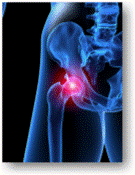Swelling
 It is normal to have pain, swelling and even blisters in your leg after surgery and during your recovery. But as the days go by, the pain and swelling should get less and less.
It is normal to have pain, swelling and even blisters in your leg after surgery and during your recovery. But as the days go by, the pain and swelling should get less and less.
Some things to do to help reduce swelling:
- Ankle pumping exercises, as you are able to.
- Do short periods of activity. It is better to start with short walks, done frequently, over the day. Be sure to balance rest and activity.
- Place an ice pack wrapped in a towel on your joint for 10-15 minutes, three times a day, after you do your exercises. Some people use a “cryocuff” – a type of ice pack that wraps around your lower leg. For more information, talk to your physiotherapist about using ice at home.
- You may wear special stockings ordered by your doctor, called Compression Stockings or TEDs. These elastic stockings put pressure on your legs after your surgery, and help the blood flow through your blood vessels. These stockings help prevent deep vein thrombosis (DVT), blood clots that form inside veins and block the blood flow.
Constipation
 Constipation after your surgery can become a problem because of a change in your diet, less activity and the effects of the pain medicine.
Constipation after your surgery can become a problem because of a change in your diet, less activity and the effects of the pain medicine.
Prevention is best way to avoid constipation
- Eat lots of fibre. Aim for 25 to 35 grams of fibre every day by eating such foods as prunes, bran, beans, lentils, fruits and vegetables.
- Drink plenty of fluids. Try to drink at least 8 cups (2 litres) of water or low-calorie fluid every day.
- Move around as much as you can – do your exercises!
Your nurse may give you laxatives or stool softeners. You may need to keep taking these medicines at home. If you have constipation at home, talk to your pharmacist. Constipation can be serious, so don’t ignore your symptoms!
Anemia (low blood count)
 Anemia after joint replacement surgery could result from blood loss from surgery. If you show any signs of anemia (the medical term for not having enough blood in the body) contact your family doctor. You may need an iron supplement. The signs of anemia are:
Anemia after joint replacement surgery could result from blood loss from surgery. If you show any signs of anemia (the medical term for not having enough blood in the body) contact your family doctor. You may need an iron supplement. The signs of anemia are:
- Feeling dizzy or faint
- Feeling very tired
- Shortness of breath with or without activity
- Rapid pulse
Joint Loosening
Over many years, the bond between the joint replacement and your bone may loosen. This can cause pain and make it difficult for you to move your new joint. To lower the chances of this happening, avoid high-impact physical activities. If you notice more pain in your new joint, talk to your doctor right away.
Call 911 if your surgical leg is suddenly extremely painful, shortened or the hip cannot be moved.
Hip Joint Dislocation (for Hip Replacement Surgery patients only)
If your hip joint moves out of place, you may notice:
- Severe pain such that you may be unable to move or bear weight on the affected leg
- A change in where you feel the pain in your hip.
- A change in the shape of your hip.
- Your hip gets stuck in one position.
Call 911 if your surgical leg is suddenly extremely painful, shortened or the hip cannot be moved.